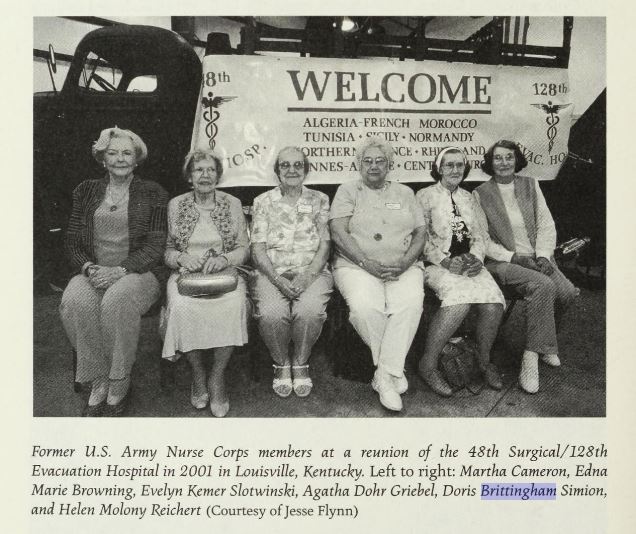above Lt. Doris Brittingham - Lt. Edna Browning - Lt. Marthe Cameron of the 128th Evacuation Hospital board the USS Pendleton after D-Day in Bristol, England for the beachheads in France. Photo from book "And if I Perish"
Seventy-five years ago today Lt Doris Brittingham,
a nurse with the US Army 128th Evacuation Hospital, jumped from her
landing craft into the water off Utah Beach, Normandy France and waded ashore. This would be her third beach head with
previous landing in North Africa and Sicily.
She would carry with her a 26 pound backpack and 15 pounds of medical
supplies. Today’s popular movies of the D Day Landing
show beaches following the first day to be cleaned up and just a lot of traffic
of troops landing supplies. In truth on
D day plus 4, dead bodies still floated in the surf at Utah beach, German artillery
shells still hit the water around the landing boats, and German mines still
floated in the water.
The 128th would consist of 22 medical
officers, 1 Chaplain, 60 Nurses and 250 enlisted personnel
From the internet history of the 128th at Normandy
The first night was spent in pup tents, with friendly planes
overhead and enemy artillery fire going on night and day. As a result of
difficulties in discharging cargo, no significant amount of medical supplies
came ashore before 12 June. Supplies however soon increased both in volume and
regularity and depots were set up in open fields short distances inland, such
as Le Grand Chemin, behind Utah Beach. The 261st Medical Battalion, 1st Engineer
Special Brigade, almost exclusively handled the seashore
movement of casualties out of Normandy. Acting as a kind of holding unit after
Field and Evacuation Hospitals opened, the Battalion funnelled patients to the
2d Naval Beach Battalion, which put them on LSTs and British Hospital Carriers
for evacuation to England. While Field Hospitals proved more than equal to
their task, the 400-bed Evacuation Hospitals found themselves consistently
overburdened; the arrival of additional Evacuation Hospitals helped contain the
flow of patients, but in many cases a chronic surgical backlog persisted.
During its first two weeks in Normandy, all but 360 out of 3,200 patients
treated at the 128th Evac required surgery. Surgical staff worked in 12-hour
shifts, although reinforced by extra Auxiliary Surgical Teams, and together
they could perform about 100 major operations every 24-hours. The trouble was
that the patient influx during heavy combat occurred at about double that rate,
so that less urgent cases had to wait for surgery! First Army deployed extra
Surgical Teams and mobile truck-mounted Surgical and X-Ray units (mounted on
modified 2 ½-Ton Cargo Trucks) of the 3d Auxiliary Surgical Group,
and detached provisional medical teams from ComZ Hospitals to help overcome the
backlog!
By 2 July hospital personnel began to care for German PWs after
the German surrender of Cherbourg, where all organized resistance had ceased on
1 July. The German front was broken and on 19 July St-Lô was captured which
would later become the starting point for General Patton’s thrust towards
Avranches. After a week of rest and refitting, First Army launched a new
Offensive, “Operation Cobra” in an effort to break the front. Following intense
aerial bombing (with some bombing errors killing friendly troops), American
Forces heavily attacked on 25 July and forced the enemy to withdraw. The
members of the 128th found themselves packing and moving to La Forêt for three
days. The constant move caused by Allied progress on the battlefront often
resulted in change of plans and hasty improvisation, and this is where training
proved its worth.
Lt Brittingham is mentioned in a few newspaper
articles and books. She would be high on
the pecking order of photographers and newspapermen when reporting; being
Female, White and an officer. Enlisted
man Frank A. Simion was also with the 128th . He was on the opposite end of the pecking
order of newspaper reporting. Born in
Kansas with Italian immigrants for parents and working in Michigan before the
war as an automaker assembler he would endure the same beachheads as the
nurses and other members of the 128th. Frank Simion
however would marry Lt Brittingham.
Lt Brittingham was a 1938 graduate of Delmar High
School and the daughter of Milos Smiley Brittingham and Hannah Dodd Hearn
Brittingham. After graduation she had
moved to Wilmington where she became a nurse in 1941 at the Delaware hospital and
in February 1941 join the Army Nurse Corp.
Her sister and brother were Irma and Reese Brittingham and both would
remain in the Delmar area. Reese would
become the owner of Bryan and Brittingham Hardware store. Irma would marry Edmund Pollack Messick.
Frank and Doris would live briefly in Delmar while
their daughter Esther Jo was born at PGH in Salisbury. They would move to Michigan where Frank would
go back to working in the automobile industry.



No comments:
Post a Comment